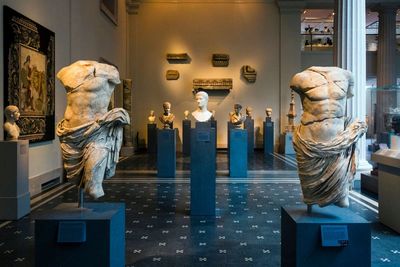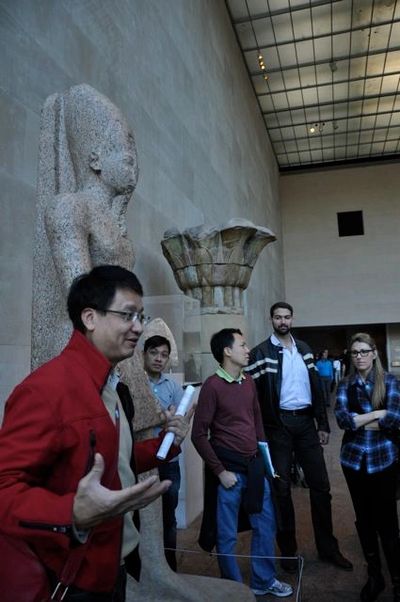Past Museum Tour

Q3. Emergence of Humanity - Human Evolution & the Bible
October 14, 2018
ACT’s guided tour of the AMERICAN MUSEUM OF NATURAL HISTORY’s Hall of Human Origins shall explore the human journey from scientific and biblical perspectives.
In 1758 Carl Linnaeus introduced the name Homo sapiens to describe humans. Until the 19th century most Christians assumed that the Bible offers a historical and scientific account of how we came about. The 1856 discovery of Neanderthal Man came as a shock to Christian theologians and launched the scientific study of human origins or paleoanthropology. In 1871, Charles Darwin published his Descent of Man and added to the noisy debate.
The story of human origins is not complete and although there is significant agreement about the main ideas, there is no full consensus among the scholars. This is because archeology is a work-in-progress and every objectiveartifact requires subjectiveinterpretations. Furthermore, fossils are stone imprints of bonesand do not directly tell us anything about the biological body. However, in rare cases, organic matter has been preserved. Today, the genomics of ancient DNA can trace the story of human migrations across the globe and tell us about our various ancestors who roamed this planet from Africa to Europe, Asia, Oceania and the Americas.
On this visit, we shall take a look at Ethiopia’s Lucy, South Africa‘s Little Foot,Tanzania’s Laetoli Footprints, Germany’s Neanderthals, and Indonesia’s Hobbits. Of the many human species that existed, we alone survived. How might we make sense of pre-humans in the light of Scripture?Whatdoes it mean to be created in God's image?
In an interdisciplinary assessment, we must note that scientific museums do not mount theological exhibits and religious texts were not written as scientific reports.
Join us on October 14th for this guided tour and along with the Psalmist, we might ask of God “What is Man that thou art mindful of Him?” (Psalm 8:5)
Public Lecture (FREE)
Location: Trinity Grace Church at 163 West 97th Street
Time: 12.00 AM - 12:45 PM
Guided Tour ($20 plus Museum admission)
Location: Hall of Human Origins, American Museum of Natural History, Central Park West & 79th Street
Time: 2:00 PM - 3:00 PM
Guide: Dr. Ron Choong, LLB Hons (London), STM (Yale), PhD (Princeton Seminary
Past Museum Tours
Q1. Origin & Creation of the UNIVERSE
Sunday, July 1, 2018
Our lecture and guided tour of the AMERICAN MUSEUM OF NATURAL HISTORY’s Hall of the Universe will examine astronomy and the Christian belief in God.
The universe began with a cosmic battle between GRAVITY, which crushes and RADIATION, which expands. Radiation overcame gravity, resulting in LIGHT.
Yes, Genesis 1:3 "Let there be light" comes to mind.
Today, everything we learn in astronomy comes from detecting and measuring lights from the sky. Astronomy began as astrology, an agricultural survival strategy which influenced cultures held together by beliefs. The first humans looked up at the bright lights in the night sky and learned to count time by observing their movement. These changing patterns of light mark the passage of time, which helped to predict the seasons for agriculture.
Communities were formed, sharing beliefs about visible and invisible powers.
The focus of attention in religious worship were these invisible powers. Indeed, the Nicene Creed begins with the words: "I believe in God, the Father almighty, maker of heaven and earth” and adds “of all things visible and invisible."
Science and theology are partners to understand our existence in the context of the visible and the invisible. Our interdisciplinary exploration of this museum will consider the convergence between theology and cosmogony.
Join us on Sunday, July 1st 2018 for a Public Lecture (FREE)
Guided Museum Tour
Museum admission plus $20 or $30 at the Door
Location: Hall of the Universe, American Museum of Natural History, Central Park West & 79th Street
Time: 2:00 PM - 3:00 PM
Guide: Dr. Ron Choong, LLB Hons (London), STM (Yale), PhD (Princeton Seminary)

L7. Lecture on the Roman World & the Bible December 3 @ 2:00 pm - 3:00 pm
This is a public lecture and is free.
Jesus conducted his ministry as a Jew in Galilee and Judea. These areas were influenced by the trade, culture, and political structures of the larger Roman world. The cities of Sepphoris and Tiberias played a major role in spreading Roman influence in Galilee. Herod Antipas, the Roman client-king of Galilee during Jesus’ time, established them. He honored his boss, the Roman emperor, by renaming Sepphoris as “Autocratoris,” a Greek form of the Latin imperial designation “Imperator.” Herod also named Tiberias after the emperor Tiberius. Roman cities exhibited and promoted features of Roman culture—architecture, teachers and philosophers, roads and bathhouses, temples and markets, and entertainment such as the Roman theater at Sepphoris. Nazareth, Jesus’ hometown, was about four miles from Sepphoris. How might Roman culture have influenced Jesus, Peter, James, John and Paul? Some have seen connections between Jesus’ actions, such as his working of miracles, and the broader culture, which included other miracle workers. We shall dip into this amazing period in history to better understand the Bible. This lecture is free but please register.
M4. Biblical Tour of the Roman Galleries - December 3 @ 4:00 pm - 5:00 pm
On this tour, Dr Choong and Mr Danny Lee will share the main influences of Roman cultures on the writing of the Bible with specific references to artifacts in these galleries.
Three themes of Roman Religious Thought:
1. LIFE & SUFFERING: Creation accounts and the healing arts.
2. DEATH & THE AFTERLIFE: Moral cognition and preparation for the next life.
3. RELIEF & BELIEF: Emergence of religion and belief in the resurrection.

M2. Biblical Tour of Persia in the Ancient Near Eastern Gallery April 30 @ 4:00 pm - 5:00 pm
$20
Persia was arguably the most important cultural influence on the writing of the Bible. Following his 2013 field expedition to Iran, Dr Ron Choong developed a series of lectures which will culminate in this inaugural museum tour in 2017.
Ever wondered about the Ancient Near East where Abraham, Isaac, and Jacob lived in? What were the contemporary cultural, political, and social contexts from which Israel emerged as a nation? Understanding the geohistorical, philosophical, and scientific contexts of the Old Testament is instrumental to study the Word of God.
In this field trip, we will look at the Metropolitan Museum’s Persian collection of artifacts to examine the parallel writings of the Ancient Near East and the Old Testament. Each of the artifacts in the museum clarifies or affirms the texts of the Bible. The religions of ancient Israel resulted in the monotheism of YHWH worship through a long period of evolving shifts in moments of geohistory and socioeconomic politics. The question raised by ancient Israel that prompted the writings of the OT was, “Are we still YHWH’s people?” The answer was a resounding “Yes”.
Every Christian who seeks to evangelize and proclaim the Gospel faithfully is responsible to read the Bible with integrity. This includes a need to be aware of the contexts that make up the cultural matrix. Then we may more accurately discover the message conveyed through the medium we call the Holy Bible.
This website uses cookies.
We use cookies to analyze website traffic and optimize your website experience. By accepting our use of cookies, your data will be aggregated with all other user data.
